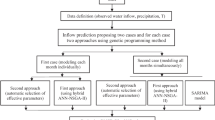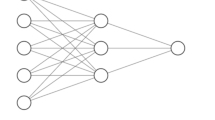Abstract
Reservoir is regarded as one of the most important engineering measures in promoting the high-efficiency utilization of the limited water resources, like water supply, peak operation, power generation and environment protection. Accurate discharge data simulation and prediction information is an essential factor to achieve the expected goals. With the booming development of computer technologies, machine learning is becoming increasingly popular in water resource field. As a classical machine learning approach, adaptive neuro-fuzzy inference system (ANFIS) may fail to effectively capture the nonstationary features of discharge time series in practice. In order to alleviate this problem, this paper develops a hybrid discharge time series simulation method, where the emerging cooperative search algorithm (CSA) is used to find the satisfying parameter combinations of the ANFIS model for the first time. To prove its feasibility and effectiveness, the proposed method is used to simulate multiple-time-scale discharge data of a huge reservoir in China. Based on several statistical indicators, the experiment results indicate that the developed method yields better simulation results than the conventional ANFIS model. Thus, the utilization of swarm intelligence tools can effectively improve the performances of machine learning models in simulating discharge data under hydropower reservoir operation.






Similar content being viewed by others
Availability of Data and Materials
Due to the strict security requirements from the departments, some or all data, models, or code generated or used in the study are proprietary or confidential in nature.
References
Bagheri AR, Aramesh N, Sher F, Bilal M (2021) Covalent organic frameworks as robust materials for mitigation of environmental pollutants. Chemosphere 270:129523
Bai T, Wu L, Chang JX, Huang Q (2015) Multi-Objective optimal operation model of cascade reservoirs and its application on water and sediment regulation. Water Resour Manag 29(8):2751–2770
Bhat SA, Bashir O, Bilal M, Ishaq A, Din Dar MU, Kumar R, Bhat RA, Sher F (2021) Impact of COVID-related lockdowns on environmental and climate change scenarios. Environ Res 195:110839
Cai X, McKinney DC, Lasdon LS (2001) Solving nonlinear water management models using a combined genetic algorithm and linear programming approach. Adv Water Resour 24(6):667–676
Catalão JPS, Pousinho HMI, Mendes VMF (2011) Hybrid wavelet-PSO-ANFIS approach for short-term wind power forecasting in Portugal. IEEE T Sustain Energ 2(1):50–59
Chang FJ, Wang KW (2013) A systematical water allocation scheme for drought mitigation. J Hydrol 507:124–133
Chang J, Wang X, Li Y, Wang Y, Zhang H (2018) Hydropower plant operation rules optimization response to climate change. Energy 160:886–897
Chau KW, Wu CL, Li YS (2005) Comparison of several flood forecasting models in Yangtze River. J Hydrol Eng 10(6):485–491
Feng Z, Niu W, Cheng C, Zhou J, Yang T (2022a) China’s hydropower energy system toward carbon neutrality. Front Eng Manage. https://doi.org/10.1007/s42524-022-0196-2
Feng ZK, Shi PF, Yang T, Niu WJ, Zhou JZ, Cheng CT (2022b) Parallel cooperation search algorithm and artificial intelligence method for streamflow time series forecasting. J Hydrol 606:127434
Ji CM, Zhou T, Huang HT (2014) Operating rules derivation of jinsha reservoirs system with parameter calibrated support vector regression. Water Resour Manag 28(9):2435–2451
Jiang Z, Qin H, Wu W, Qiao Y (2017) Studying operation rules of cascade reservoirs based on multi-dimensional dynamics programming. Water (Switzerland) 10(1)
Kaluarachchi Y (2021) Potential advantages in combining smart and green infrastructure over silo approaches for future cities. Front Eng Manage 8(1):48–59
Liu B, Wang H, Lei X, Liu Z, Quan J (2018) Emergency operation rules for water-supply reservoirs under uncertainty and risk in dry seasons. Water Sci Technol: Water Supply 18(5):1682–1695
Liu P, Guo S, Xu X, Chen J (2011) Derivation of Aggregation-Based joint operating rule curves for cascade hydropower reservoirs. Water Resour Manag 25(13):3177–3200
Ma C, Lian J, Wang J (2013) Short-term optimal operation of Three-gorge and Gezhouba cascade hydropower stations in non-flood season with operation rules from data mining. Energ Convers Manage 65:616–627
Ming B, Liu P, Bai T, Tang R, Feng M (2017) Improving optimization efficiency for reservoir operation using a search space reduction method. Water Resour Manag 31(4):1173–1190
Nabavi-Pelesaraei A, Rafiee S, Mohtasebi SS, Hosseinzadeh-Bandbafha H, Chau KW (2018) Integration of artificial intelligence methods and life cycle assessment to predict energy output and environmental impacts of paddy production. Sci Total Environ 631–632:1279–1294
Niu W, Feng Z, Li S, Wu H, Wang J (2021) Short-term electricity load time series prediction by machine learning model via feature selection and parameter optimization using hybrid cooperation search algorithm. Environ Res Lett 16(5):055032. https://doi.org/10.1088/1748-9326/abeeb1
Peng AB, Peng Y, Zhou HC, Zhang C (2014) Multi-reservoir joint operating rule in inter-basin water transfer-supply project. Sci China Technol Sci 58(1):123–137
Safavi HR, Chakraei I, Kabiri-Samani A, Golmohammadi MH (2013) Optimal reservoir operation based on conjunctive use of surface water and groundwater using Neuro-Fuzzy systems. Water Resour Manag 27(12):4259–4275
Shen Z, Liu P, Ming B, Feng M, Zhang X, Li H, Xie A (2018) Deriving optimal operating rules of a Multi-Reservoir system considering incremental Multi-Agent benefit allocation. Water Resour Manag 32(11):3629–3645
Sher F, Hanif K, Rafey A, Khalid U, Zafar A, Ameen M, Lima EC (2021) Removal of micropollutants from municipal wastewater using different types of activated carbons. J Environ Manage 278:111302
Tan QF, Wen X, Fang GH, Wang YQ, Qin GH, Li HM (2020) Long-term optimal operation of cascade hydropower stations based on the utility function of the carryover potential energy. J Hydrol 580
Taormina R, Chau KW, Sivakumar B (2015) Neural network river forecasting through baseflow separation and binary-coded swarm optimization. J Hydrol 529:1788–1797
Wang WC, Chau KW, Cheng CT, Qiu L (2009) A comparison of performance of several artificial intelligence methods for forecasting monthly discharge time series. J Hydrol 374(3–4):294–306
Wen S, Dong M, Yang Y, Zhou P, Huang T, Chen Y (2020) End-to-end detection-segmentation network for face labeling. IEEE Trans Emerg Topics Comput Intell. https://doi.org/10.1109/TETCI.2019.2947319
Xu W, Liu P, Cheng L, Zhou Y, Xia Q, Gong Y, Liu Y (2021) Multi-step wind speed prediction by combining a WRF simulation and an error correction strategy. Renew Energ 163:772–782
Xu YP, Gao X, Zhu Q, Zhang Y, Kang L (2015) Coupling a regional climate model and a distributed hydrological model to assess future water resources in Jinhua River Basin, East China. J Hydrol Eng 20(4)
Yang T, Asanjan AA, Faridzad M, Hayatbini N, Gao X, Sorooshian S (2017a) An enhanced artificial neural network with a shuffled complex evolutionary global optimization with principal component analysis. Inform Sci 418–419:302–316
Yang T, Asanjan AA, Welles E, Gao X, Sorooshian S, Liu X (2017b) Developing reservoir monthly inflow forecasts using artificial intelligence and climate phenomenon information. Water Resour Res 53(4):2786–2812
Yin D, Roderick ML (2020) Inter-annual variability of the global terrestrial water cycle. Hydrol Earth Syst Sc 24(1):381–396
Yuan X, Ji B, Tian H, Huang Y (2014) Multiscaling analysis of monthly runoff series using improved MF-DFA approach. Water Resour Manag 28(12):3891–3903
Zeng X, Hu T, Cai X, Zhou Y, Wang X (2019) Improved dynamic programming for parallel reservoir system operation optimization. Adv Water Resour 131:103373
Zhang P, Ariaratnam ST (2021) Life cycle cost savings analysis on traditional drainage systems from low impact development strategies. Front Eng Manage 8(1):17–31
Zhang W, Lei X, Liu P, Wang X, Wang H, Song P (2019) Identifying the relationship between assignments of scenario weights and their positions in the derivation of reservoir operating rules under climate change. Water Resour Manag 33(1):261–279
Zhao J, Wang Z, Wang D, Wang D (2009) Evaluation of economic and hydrologic impacts of unified water flow regulation in the yellow river basin. Water Resour Manag 23(7):1387–1401
Zhao T, Wang QJ, Bennett JC, Robertson DE, Shao Q, Zhao J (2015) Quantifying predictive uncertainty of streamflow forecasts based on a Bayesian joint probability model. J Hydrol 528:329–340
Zheng F, Qi Z, Bi W, Zhang T, Yu T, Shao Y (2017) Improved understanding on the searching behavior of NSGA-II operators using Run-Time measure metrics with application to water distribution system design problems. Water Resour Manag 31(4):1121–1138
Funding
This paper is supported by the Fundamental Research Funds for the Central Universities (B210201046), National Natural Science Foundation of China (52009012), Natural Science Foundation of Hubei Province (2020CFB340).
Author information
Authors and Affiliations
Contributions
Wen-jing Niu: Conceptualization, Methodology, Writing, Investigation, Funding acquisition. Zhong-kai Feng: Conceptualization, Supervision, Writing, Investigation, Funding acquisition. Peng-fei Shi: Formal analysis, Writing, and Visualization. Tao Yang: Data curation, Writing, and Programming.
Corresponding author
Ethics declarations
Consent to Participate
Not applicable.
Consent to Publish
Not applicable.
Competing Interest
The authors declare no competing interests.
Additional information
Publisher's Note
Springer Nature remains neutral with regard to jurisdictional claims in published maps and institutional affiliations.
Rights and permissions
About this article
Cite this article
Feng, Zk., Niu, Wj., Shi, Pf. et al. Adaptive Neural-Based Fuzzy Inference System and Cooperation Search Algorithm for Simulating and Predicting Discharge Time Series Under Hydropower Reservoir Operation. Water Resour Manage 36, 2795–2812 (2022). https://doi.org/10.1007/s11269-022-03176-3
Received:
Accepted:
Published:
Issue Date:
DOI: https://doi.org/10.1007/s11269-022-03176-3




